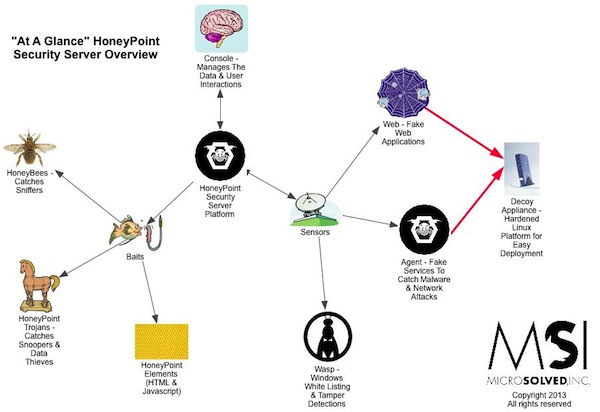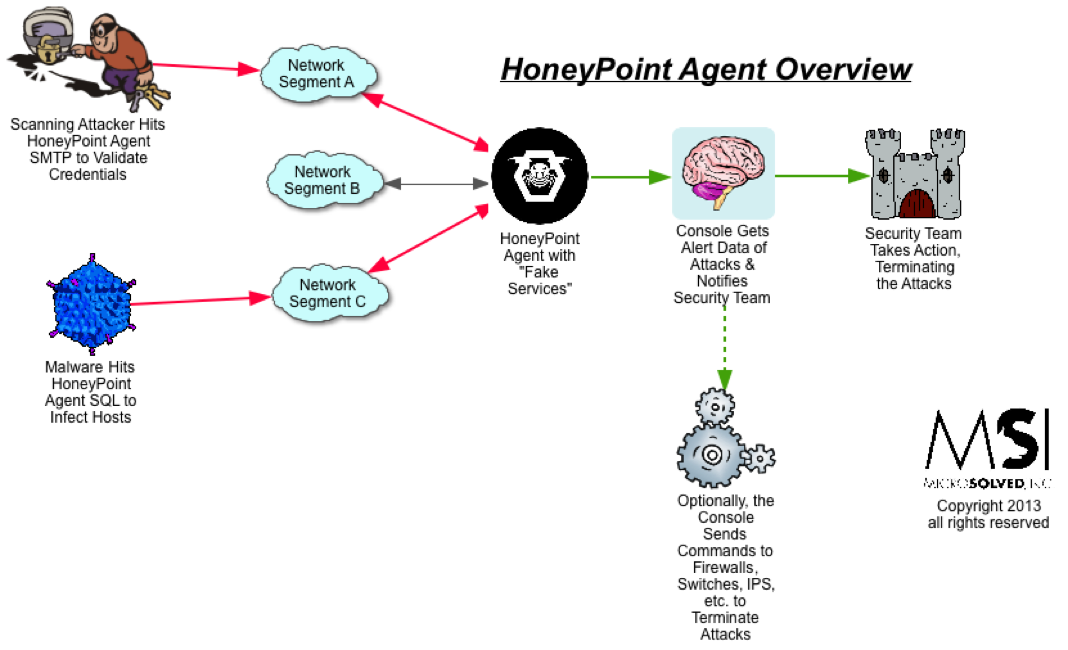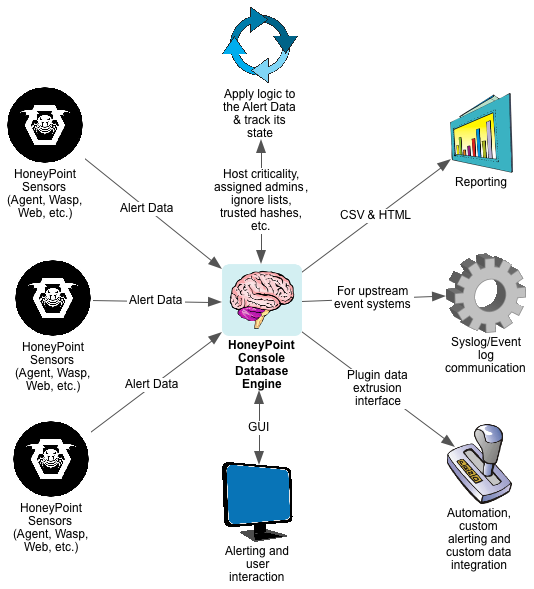Many folks have been asking us for an “At a Glance” kind of graphic about HPSS. Here is a first attempt. Please let us know what you think via the comments or on Twitter (@microsolved). Thanks for reading!


Many folks have been asking us for an “At a Glance” kind of graphic about HPSS. Here is a first attempt. Please let us know what you think via the comments or on Twitter (@microsolved). Thanks for reading!

This post builds on the What is HPSS? Series. Previous posts are here and here.
HoneyPoint Agent is the original detection capability of the HoneyPoint Security Server suite. Basically, it allows a system to offer up a variety of “fake services” to the network for the purpose of detection. These services can either be simple port listeners or can be complex, deeper emulations of protocols like SMTP, HTTP, Telnet, FTP, etc. These ports have no real users and no legitimate traffic flows to them. This means that anytime these ports are tampered with, the interactions are “suspicious at best and malicious at worst”.

Other organizations deploy Agent more sporadically, either using virtual or physical appliances dedicated to HoneyPoint hosting. These organizations often assign multiple physical or virtual interfaces to the devices, allowing them to have a presence on many network segments at the same time.
Still other users leverage an approach called “scattersensing” by deploying HoneyPoint on systems that they move periodically around their environment. This makes for a less dependable detection mechanism, but gives them the capability to get more vision into “hotspots” where targeting is expected or where malware is more likely to pop-up.
The most successful HoneyPoint Agent deployments use a combination of these tactics, along with including strategies like DNS redirection of known command and control sites and other more active forms of getting bad traffic into the HoneyPoint systems.
HoneyPoint Agent has proven to be very useful in identifying scanning and malware outbreaks. Customers with supposedly secure networks have found malware that had been missed for years by their traditional internal security tools. These were detected when the ongoing slow and low scanning triggered HoneyPoint deployments, particularly for SQL, Terminal Server and other commonly targeted ports.
HoneyPoint Agent can be configured through the command line or via a GUI application, making it easy to manage and deploy. Once installed, it is a “deploy and forget” style tool which doesn’t require ongoing tuning or signature updates. Generally speaking, customers deploy Agent and it runs for years without feeding and care.
HoneyPoint Agent also features MSI’s patented “defensive fuzzing” capabilities (previously known as HornetPoint mode), which can create self-defending services that attempt to take down attacker tools during their probing to interfere with propagation. Still other users automate defense with Agent using it as a means for black holing hosts that probe their environment. In these optional, more active roles, Agent can help organizations strengthen their posture with a “one strike and you’re out” kind of approach.
HoneyPoint Agent runs in Linux, Windows and OS X. It communicates securely with the HoneyPoint Console. It also features user configurable services, a known scanning host ignore list (for ongoing vulnerability assessment clients) and a wide variety of common service emulation templates (available through support).
To learn more about HoneyPoint Security Server or to get a demo, please contact us. We would be happy to walk you through the product and discuss how it might fit into your environment. There is even a free for personal use “Community Edition” available to get you started or to let you experience the power, ease and flexibility of the platform yourself. Just give us a call to learn more about HoneyPoint Security Server and HoneyPoint Agent. You’ll be glad you did!
This article builds on the What is HPSS? Series. The original overview article is here.
The HoneyPoint Security Server Console is the “brain” of the HoneyPoint product platform. It is the central component responsible for getting alert data from the sensors, tracking and maintaining the alert data, presenting it to the user and safely passing the essential alert data on to the automated plugins or other systems in the security event chain.

The Console is a GUI application that includes a built-in database engine for tracking Alert Data state and to empower reporting and analysis over time. Alert Data from the sensors are sent to the Console over TCP and the data is encrypted. The Console application runs on Windows, Linux and OS X.
Once the Console receives Alert Data from the sensors, it parses it to validate that the data is good and checks to see what actions it should take based on the alerting configuration, assigned admins list, ignored hosts lists, and other trust rules in place.
It then presents the alert data to the appropriate mechanisms, alerting users, passing the desired elements of the alert data to syslog/event log on the Console system for upstream processing by SEIMs or other event tools. The Console also passes certain event data as determined by the configuration into the “plugins mechanism”.
The plugins then execute the desired operations on the data, easily allowing the security team to further extend reporting to custom event handlers or perform automated responses. This flexible solution empowers the security team to integrate HoneyPoint Security Server fully into whatever technology platform/response process they desire or have in place.
Reporting from the Console is very simple. The included reporting engine can create a wide variety of canned reports in either CSV or HTML format, ensuing that the data in the HoneyPoint system is easy to use. Additionally, other reporting tools like Crystal Reports or the like, or even languages like PERL, Python or Ruby, can easily attach to the Console database to create whatever types of custom reports you desire.
All in all, HoneyPoint Security Server was designed to make it easy to use and yet flexible enough for the most demanding and mature infosec teams. The console interface is friendly, functional and easily understandable. Most teams require less than a 30 minute walk through before they are off and running with the basic detection power HoneyPoint provides. When they get comfortable with the system, they quickly master the plugins meta-language and are soon automating large groups of detection and response tasks.
To learn more about HoneyPoint Security Server or to get a demo, please contact us. We would be happy to walk you through the product and discuss how it might fit into your environment. There is even a free for personal use “Community Edition” available to get you started or to let you experience the power, ease and flexibility of the platform yourself. Just give us a call to learn more about HoneyPoint Security Server Console. You’ll be glad you did!
Launched in 2006, initially as a distributed honey pot product, HoneyPoint Security Server (HPSS) has grown well beyond the initial concept. Today HPSS is a platform of components woven into a tightly integrated, fully capable, extremely flexible threat detection product. Organizations around the world are using it as a means of early detection of internal and external attackers, malware outbreaks and signs of users poking around where they shouldn’t be. Mature organizations have leveraged the product as a means of deterring attacks through automated black holing of scanning hosts on their perimeter, embedded detective controls inside their web applications to cut off users violating their terms of service and gather real world threat metrics to feed back into their mature risk management initiatives.
In the world of ICS/SCADA, HoneyPoint has found a quickly growing set of fans. HPSS can be deployed in a completely passive way that has no chance of interfering with critical operations, yet still brings incredible detection capability and vision into even the most sensitive of networks. ICS/SCADA environments have traditionally embraced the honeypot ideal, coining the term “canary” for these tools, but never before have they had such an easy to use, distributable, centrally monitored honeypot capability like HoneyPoint brings to the table.
Over the next few months, we will be deep diving into each of the HPSS components, but for now, as a high-level overview, here is a quick and dirty explanation of each of them:
To learn more about these components and how they can be leveraged to give your organization new, flexible and deep detection capabilities, give us a call. Our engineers would be glad to discuss the technical capabilities and an account executive would be happy to work with you to create a HoneyPoint deployment that meets your needs AND your budget. At MicroSolved, we are passionate about information security and HoneyPoint Security Server is just another that way it shows!

HoneyPoint has a component called a HoneyBee that can help organizations detect sniffing on their networks. The tool works like this:
By properly configuring the setup, this approach makes for a very effective tool to catch sniffing malware and attackers. Backing the credentials up with other detection mechanisms, such as in web applications and on AD forests can extend the approach even further. Our team has helped organizations stand up these kinds of nuance detection schemes across a variety of platforms.
Even though the approach seems quite simple, it has proven to be quite adept at catching a variety of attacks. Customers continue to tell us that HoneyBees working with HoneyPoint Agent have been key indicators of compromise that have led them to otherwise undetected compromises.
HoneyBees are just another example of some of the ways that people are using the incredible flexibility of HoneyPoint to do nuance detection more easily than ever before. Gaining vision where they never had it has paid off, and HoneyPoints ability to turn vision into intelligence has proven itself over and over again.
To discuss HoneyPoint, HoneyBees or other forms of nuance detection, get in touch with MicroSolved. We would be happy to discuss how we can help your organization get more vision all around your enterprise.
Brent Huston, CEO and Security Evangelist for MicroSolved, Inc., explains how organizations need to move from a focus on prevention to detection.
Joined by MSI’s Account Executive Chris Lay and Marketing Communication Specialist Mary Rose Maguire, Brent maps out how an organization can get detective controls closer to the data and shows that IT departments can have a “payoff” if they pursue nuanced detection.
We’re excited to be a part of this year’s 5th Annual 2012 Central Ohio InfoSec Summit! Each year it keeps getting better and better, and this year is no different.
MicroSolved’s CEO and founder, Brent Huston will be presenting “Detection in Depth: Changing the PDR Focus.” Phil Grimes will also present “Attacking Mobile Devices” in the Advanced Technical Track.
There are other great speakers lined up. Included are:
There are more great speakers, plus over thirty vendors who help businesses stay secure. We hope to see you at the event! It promises to be a great time re-connecting with old friends, making new connections, and learning new approaches toward a proactive information security strategy.
See you there!
On May 18th, I will be presenting on detection in depth at the CMH ISSA Summit. I look forward to a good discussion of the ideals, organizational needs, and maturity models. Given all of the focus on re-allocating resources from “prevention only” strategies to an equal spread across the core values of prevention, detection and response, this is likely to be a useful discussion to many organizations.
One of the biggest signs that an organization’s information security program is immature is when they have an obsessive focus on prevention and they equate it specifically with security.
The big signs of this issue are knee-jerk reactions to vulnerabilities, a never-ending set of emergency patching situations and continual fire-fighting mode of reactions to “incidents”. The security team (or usually the IT team) is overworked, under-communicates, is highly stressed, and lacks both resources and tools to adequately mature the process. Rarely does the security folks actually LIKE this environment, since it feeds their inner super hero complex.
Furthering the discussion on how detection in depth works, here is an example that folks have been asking me to demonstrate. This is a diagram that shows an asset, in this case PII in a database that is accessed via a PHP web application. The diagram shows the various controls around detection in place to protect the data at the various focus levels for detection. As explained in the maturity model post before, the closer the detection control is to the asset, the higher the signal to noise ratio it should be and the higher the relevance o the data should be to the asset being protected (Huston’s Postulate).